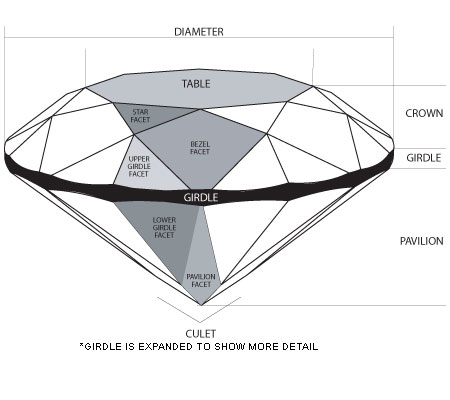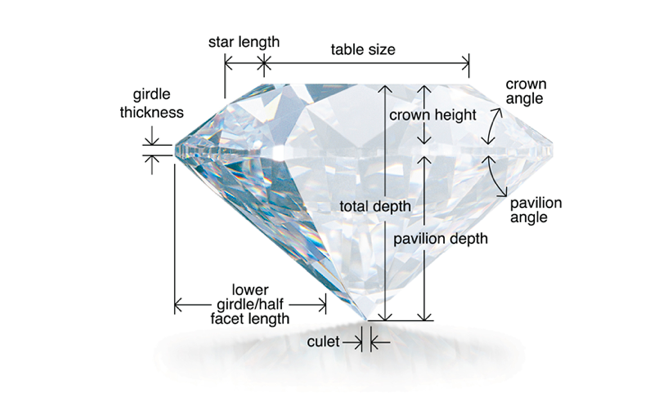Diamond Anatomy Explained – Understanding the Anatomy, Sides and Corners of Lab Grown Diamonds


You may have lab-grown diamonds in your collection. But do you know them inside out?
Maybe not!
While we’ve discussed a lot about the 4 Cs of diamonds, we’ve barely touched upon the diamond anatomy.
That’s why we’ve put together this guide for you to understand the anatomy of diamonds.
Let’s get started.
The Different Parts of Lab Grown Diamonds
Whether your gemstones are mined or cultured diamonds, they will have the same anatomy. Apart from the same chemical properties, they also have the same physical features.
Here’s an illustration that shows the diamond anatomy.

Source
1. Table
The table of the lab-grown diamond is the largest facet, located on the top of the stone.
2. Crown
The crown of the diamond is the facet between the table and the diamond girdle.
3. Girdle
The diamond girdle is between the crown and the pavilion. It is the perimeter of the diamond.
-
Most experts recommend a girdle that is not too thick, as they look bulky and add additional weight to the diamond.
-
An extremely thin diamond girdle could increase the chances of damage to the diamond.
4. Pavilion
The pavilion of the lab grown diamond is the bottom part between the girdle and the culet. It gives the bottom part a conical shape.
- The pavilion of a lab produced diamond has to be of the correct depth—too deep or too shallow will lead to light escaping and affect brilliance.
5. Culet
The culet is the bottom most part of the diamond. It is a tip or a point—the portion that goes into the jewelry setting.
6. Diameter
The diameter is measured as the width of the girdle.
Now that we know what the different parts of the lab grown diamond are called and their specifics, let’s also understand the diamond 4Cs and what they mean for the different diamond parts.
The 4 Cs of Diamonds
Cut
Rough lab-grown diamonds have to be cut to get a desired shape out of them. However, the word "cut" doesn't only apply to shapes like round, oval, heart, pear, etc. Diamond cut also provides a diamond with its angles, facets, proportions, and finishing. The lab produced diamond's cut determines its performance and brilliance, making it the most crucial element.
Here’s the standard diamond cut grade chart to help you choose the best lab grown diamonds.
Color
Although diamonds appear colorless to the naked eye, a closer inspection could reveal some hues or colors. Moreover, there are a wide range of colored lab-grown diamonds as well. Diamond colors are ranked in alphabetical order.
-
D is regarded as the ideal shade for a diamond.
-
As the diamond color begins to turn yellow or brownish, they are graded as E, F, G, H, and so forth.
Here is a diamond color grading chart you could use as reference for your cultured diamonds:

Source
Clarity
Another of the 4 Cs of diamonds is clarity. Clarity refers to the diamond inclusions (internal characteristics) and blemishes (external characteristics) in diamonds. Inclusions and imperfections are graded according to their size, type, and location.
Carat
Carat weight is another of diamonds’ 4Cs. A diamond's weight is measured in carats. Carats weigh 0.200 grammes. 100 points can be used to divide up each carat. Some of the popular carat weight sizes are: 0.5 carat, 1 carat, 1.5 carat, 2 carat lab diamond, 2.5 carat, 3 carat, 4 carat lab grown diamond, and 5 carat.
Summing up this Diamond Guide
Now you know the in and out of cultured diamonds. This diamond guide will help you in assessing diamonds before you make purchases. You can also refer to this guide to design your customized jewelry based on the anatomy and different features of diamonds.

{"AutoID":138,"DateCreation":"\/Date(1711972806463)\/","DateModified":"\/Date(1755761246613)\/","CreatedBy":null,"ModifiedBy":"Rahul Bohra ","RecordStatus":"A","Title":"Diamond Anatomy Explained – Understanding the Anatomy, Sides and Corners of Lab Grown Diamonds","SubTitle":null,"Description":"\u003cp dir=\"ltr\"\u003eYou may have lab-grown diamonds in your collection. But do you know them inside out?\u0026nbsp;\u003c/p\u003e\r\n\r\n\u003cp\u003e\u0026nbsp;\u003c/p\u003e\r\n\r\n\u003cp dir=\"ltr\"\u003eMaybe not!\u0026nbsp;\u003c/p\u003e\r\n\r\n\u003cp\u003e\u0026nbsp;\u003c/p\u003e\r\n\r\n\u003cp dir=\"ltr\"\u003eWhile we\u0026rsquo;ve discussed a lot about the \u003ca href=\"https://www.growndiamondcorp.com/blog/the-4cs-of-diamond-grading-all-you-need-to-know/\"\u003e4 Cs of diamonds\u003c/a\u003e, we\u0026rsquo;ve barely touched upon the diamond anatomy.\u003c/p\u003e\r\n\r\n\u003cp\u003e\u0026nbsp;\u003c/p\u003e\r\n\r\n\u003cp dir=\"ltr\"\u003eThat\u0026rsquo;s why we\u0026rsquo;ve put together this guide for you to understand the anatomy of diamonds.\u0026nbsp;\u003c/p\u003e\r\n\r\n\u003cp\u003e\u0026nbsp;\u003c/p\u003e\r\n\r\n\u003cp dir=\"ltr\"\u003eLet\u0026rsquo;s get started.\u003c/p\u003e\r\n\r\n\u003cp dir=\"ltr\"\u003e\u0026nbsp;\u003c/p\u003e\r\n\r\n\u003ch2 dir=\"ltr\"\u003e\u003cstrong\u003eThe Different Parts of Lab Grown Diamonds\u003c/strong\u003e\u003c/h2\u003e\r\n\r\n\u003cp dir=\"ltr\"\u003eWhether your gemstones are \u003ca href=\"https://www.growndiamondcorp.com/blog/difference-between-synthetic-and-mined-diamonds/\"\u003emined\u003c/a\u003e or cultured diamonds, they will have the same anatomy. Apart from the same chemical properties, they also have the same physical features.\u003c/p\u003e\r\n\r\n\u003cp dir=\"ltr\"\u003e\u0026nbsp;\u003c/p\u003e\r\n\r\n\u003cp dir=\"ltr\"\u003e\u003cstrong\u003eHere\u0026rsquo;s an illustration that shows the diamond anatomy.\u003c/strong\u003e\u003c/p\u003e\r\n\r\n\u003cp dir=\"ltr\"\u003e\u0026nbsp;\u003c/p\u003e\r\n\r\n\u003cp dir=\"ltr\"\u003e\u003cstrong\u003e\u003cimg alt=\"\" src=\"https://emailer.growndiamondcorp.com/blog-images/know-your-lab-grown-diamond-anatomy-with-labels.png\" style=\"height:404px; width:672px\" /\u003e\u003c/strong\u003e\u003c/p\u003e\r\n\r\n\u003cp dir=\"ltr\"\u003e\u0026nbsp;\u003c/p\u003e\r\n\r\n\u003cp dir=\"ltr\"\u003e\u003cstrong\u003e\u003ca href=\"https://4cs.gia.edu/en-us/blog/diamond-anatomy-explained/\"\u003eSource\u003c/a\u003e\u003c/strong\u003e\u003c/p\u003e\r\n\r\n\u003cp dir=\"ltr\"\u003e\u0026nbsp;\u003c/p\u003e\r\n\r\n\u003ch3 dir=\"ltr\"\u003e\u003cstrong\u003e1. Table\u003c/strong\u003e\u003c/h3\u003e\r\n\r\n\u003cp dir=\"ltr\"\u003eThe table of the lab-grown diamond is the largest facet, located on the top of the stone.\u0026nbsp;\u003c/p\u003e\r\n\r\n\u003cul\u003e\r\n\t\u003cli dir=\"ltr\"\u003e\r\n\t\u003cp dir=\"ltr\"\u003eThe table size of a diamond graded \u0026ldquo;excellent\u0026rdquo; will be between 52 and 62 percent of the diamond girdle diameter.\u003c/p\u003e\r\n\t\u003c/li\u003e\r\n\u003c/ul\u003e\r\n\r\n\u003ch3 dir=\"ltr\"\u003e\u003cstrong\u003e2. Crown\u003c/strong\u003e\u003c/h3\u003e\r\n\r\n\u003cp dir=\"ltr\"\u003eThe crown of the diamond is the facet between the table and the \u003ca href=\"https://www.growndiamondcorp.com/blog/all-you-should-know-about-diamond-girdles/\"\u003ediamond girdle\u003c/a\u003e.\u003c/p\u003e\r\n\r\n\u003ch3 dir=\"ltr\"\u003e\u003cstrong\u003e3. Girdle\u003c/strong\u003e\u003c/h3\u003e\r\n\r\n\u003cp dir=\"ltr\"\u003eThe diamond girdle is between the crown and the pavilion. It is the perimeter of the diamond.\u0026nbsp;\u003c/p\u003e\r\n\r\n\u003cul\u003e\r\n\t\u003cli dir=\"ltr\"\u003e\r\n\t\u003cp dir=\"ltr\"\u003eMost experts recommend a girdle that is not too thick, as they look bulky and add additional weight to the diamond.\u0026nbsp;\u003c/p\u003e\r\n\t\u003c/li\u003e\r\n\t\u003cli dir=\"ltr\"\u003e\r\n\t\u003cp dir=\"ltr\"\u003eAn extremely thin diamond girdle could increase the chances of damage to the diamond.\u0026nbsp;\u003c/p\u003e\r\n\t\u003c/li\u003e\r\n\u003c/ul\u003e\r\n\r\n\u003ch3 dir=\"ltr\"\u003e\u003cstrong\u003e4. Pavilion\u003c/strong\u003e\u003c/h3\u003e\r\n\r\n\u003cp dir=\"ltr\"\u003eThe pavilion of the lab grown diamond is the bottom part between the girdle and the culet. It gives the bottom part a conical shape.\u0026nbsp;\u003c/p\u003e\r\n\r\n\u003cul dir=\"ltr\"\u003e\r\n\t\u003cli\u003eThe pavilion of a \u003ca href=\"https://www.growndiamondcorp.com/blog/types-of-lab-grown-diamonds/\"\u003elab produced diamond\u003c/a\u003e has to be of the correct depth\u0026mdash;too deep or too shallow will lead to light escaping and affect brilliance.\u003c/li\u003e\r\n\u003c/ul\u003e\r\n\r\n\u003ch3\u003e\u003cstrong\u003e5. Culet\u003c/strong\u003e\u003c/h3\u003e\r\n\r\n\u003cp\u003eThe culet is the bottom most part of the diamond. It is a tip or a point\u0026mdash;the portion that goes into the jewelry setting.\u003c/p\u003e\r\n\r\n\u003ch3\u003e\u003cstrong\u003e6. Diameter\u003c/strong\u003e\u003c/h3\u003e\r\n\r\n\u003cp dir=\"ltr\"\u003eThe diameter is measured as the width of the girdle.\u0026nbsp;\u003cbr /\u003e\r\nNow that we know what the different parts of the \u003ca href=\"https://www.growndiamondcorp.com/blog/7-lies-and-myths-about-lab-grown-diamonds-you-must-know/\"\u003elab grown diamond\u003c/a\u003e are called and their specifics, let\u0026rsquo;s also understand the diamond 4Cs and what they mean for the different diamond parts.\u003c/p\u003e\r\n\r\n\u003cp dir=\"ltr\"\u003e\u0026nbsp;\u003c/p\u003e\r\n\r\n\u003cp dir=\"ltr\"\u003e\u0026nbsp;\u003c/p\u003e\r\n\r\n\u003ch2\u003e\u003cstrong\u003eThe 4 Cs of Diamonds\u003c/strong\u003e\u003c/h2\u003e\r\n\r\n\u003ch3\u003e\u003cstrong\u003eCut\u003c/strong\u003e\u003c/h3\u003e\r\n\r\n\u003cp\u003eRough lab-grown diamonds have to be cut to get a desired shape out of them. However, the word \u0026quot;cut\u0026quot; doesn\u0026#39;t only apply to shapes like \u003ca href=\"https://www.growndiamondcorp.com/round-cut-diamonds/\"\u003eround\u003c/a\u003e, \u003ca href=\"https://www.growndiamondcorp.com/oval-cut-diamonds/\"\u003eoval\u003c/a\u003e, \u003ca href=\"https://www.growndiamondcorp.com/heart-cut-diamonds/\"\u003eheart\u003c/a\u003e, \u003ca href=\"https://www.growndiamondcorp.com/pear-cut-diamonds/\"\u003epear\u003c/a\u003e, etc. \u003ca href=\"https://www.growndiamondcorp.com/blog/which-diamond-cut-has-the-most-sparkle/\"\u003eDiamond cut\u003c/a\u003e also provides a diamond with its angles, facets, proportions, and finishing. The lab produced diamond\u0026#39;s cut determines its performance and brilliance, making it the most crucial element.\u003cstrong\u003e \u003c/strong\u003e\u003c/p\u003e\r\n\r\n\u003cp\u003e\u0026nbsp;\u003c/p\u003e\r\n\r\n\u003cp dir=\"ltr\"\u003eHere\u0026rsquo;s the standard diamond cut grade chart to help you choose the best lab grown diamonds.\u0026nbsp;\u003c/p\u003e\r\n\r\n\u003cul\u003e\r\n\t\u003cli dir=\"ltr\"\u003e\r\n\t\u003cp dir=\"ltr\"\u003eExcellent cut or ideal cut\u003c/p\u003e\r\n\t\u003c/li\u003e\r\n\t\u003cli dir=\"ltr\"\u003e\r\n\t\u003cp dir=\"ltr\"\u003eVery good cut\u003c/p\u003e\r\n\t\u003c/li\u003e\r\n\t\u003cli dir=\"ltr\"\u003e\r\n\t\u003cp dir=\"ltr\"\u003eGood cut\u003c/p\u003e\r\n\t\u003c/li\u003e\r\n\t\u003cli dir=\"ltr\"\u003e\r\n\t\u003cp dir=\"ltr\"\u003eFair cut\u003c/p\u003e\r\n\t\u003c/li\u003e\r\n\t\u003cli dir=\"ltr\"\u003e\r\n\t\u003cp dir=\"ltr\"\u003ePoor cut\u003c/p\u003e\r\n\t\u003c/li\u003e\r\n\u003c/ul\u003e\r\n\r\n\u003ch3 dir=\"ltr\"\u003e\u003cstrong\u003eColor\u003c/strong\u003e\u003c/h3\u003e\r\n\r\n\u003cp dir=\"ltr\"\u003eAlthough diamonds appear colorless to the naked eye, a closer inspection could reveal some hues or colors. Moreover, there are a wide range of \u003ca href=\"https://www.growndiamondcorp.com/blog/colored-lab-grown-diamonds-are-available-in-a-spectrum-of-shades/\"\u003ecolored lab-grown diamonds\u003c/a\u003e as well. Diamond colors are ranked in alphabetical order.\u0026nbsp;\u003c/p\u003e\r\n\r\n\u003cul\u003e\r\n\t\u003cli dir=\"ltr\"\u003e\r\n\t\u003cp dir=\"ltr\"\u003eD is regarded as the ideal shade for a diamond.\u0026nbsp;\u003c/p\u003e\r\n\t\u003c/li\u003e\r\n\t\u003cli dir=\"ltr\"\u003e\r\n\t\u003cp dir=\"ltr\"\u003eAs the diamond color begins to turn yellow or brownish, they are graded as E, F, G, H, and so forth.\u003c/p\u003e\r\n\t\u003c/li\u003e\r\n\u003c/ul\u003e\r\n\r\n\u003cp dir=\"ltr\"\u003e\u0026nbsp;\u003c/p\u003e\r\n\r\n\u003cp dir=\"ltr\"\u003e\u003cstrong\u003eHere is a diamond color grading chart you could use as reference for your cultured diamonds:\u003c/strong\u003e\u003c/p\u003e\r\n\r\n\u003cp dir=\"ltr\"\u003e\u0026nbsp;\u003c/p\u003e\r\n\r\n\u003cp dir=\"ltr\"\u003e\u003cstrong\u003e\u003cimg alt=\"\" src=\"https://emailer.growndiamondcorp.com/blog-images/gia-color-scale.png\" style=\"height:176px; width:629px\" /\u003e\u003c/strong\u003e\u003c/p\u003e\r\n\r\n\u003cp dir=\"ltr\"\u003e\u003cstrong\u003e\u003ca href=\"https://www.gia.edu/gia-about/4cs-color\"\u003eSource\u003c/a\u003e\u003c/strong\u003e\u003c/p\u003e\r\n\r\n\u003cp dir=\"ltr\"\u003e\u0026nbsp;\u003c/p\u003e\r\n\r\n\u003ch3 dir=\"ltr\"\u003e\u003cstrong\u003eClarity\u003c/strong\u003e\u003c/h3\u003e\r\n\r\n\u003cp dir=\"ltr\"\u003eAnother of the 4 Cs of diamonds is clarity. Clarity refers to the \u003ca href=\"https://www.growndiamondcorp.com/blog/do-lab-grown-diamonds-have-inclusions/\"\u003ediamond inclusions\u003c/a\u003e (internal characteristics) and blemishes (external characteristics) in diamonds. Inclusions and imperfections are graded according to their size, type, and location.\u003cstrong\u003e \u003c/strong\u003e\u003c/p\u003e\r\n\r\n\u003ch3 dir=\"ltr\"\u003e\u003cstrong\u003eCarat\u003c/strong\u003e\u003c/h3\u003e\r\n\r\n\u003cp dir=\"ltr\"\u003eCarat weight is another of diamonds\u0026rsquo; 4Cs. A diamond\u0026#39;s weight is measured in carats. Carats weigh 0.200 grammes. 100 points can be used to divide up each carat. Some of the popular carat weight sizes are: 0.5 carat, 1 carat, 1.5 carat, \u003ca href=\"https://www.growndiamondcorp.com/blog/how-to-choose-the-best-setting-for-a-2-carat-lab-created-diamond-ring/\"\u003e2 carat lab diamond\u003c/a\u003e, 2.5 carat, 3 carat, 4 carat lab grown diamond, and 5 carat.\u003cstrong\u003e \u003c/strong\u003e\u003c/p\u003e\r\n\r\n\u003cp dir=\"ltr\"\u003e\u0026nbsp;\u003c/p\u003e\r\n\r\n\u003cp dir=\"ltr\"\u003e\u0026nbsp;\u003c/p\u003e\r\n\r\n\u003ch2 dir=\"ltr\"\u003e\u003cstrong\u003eSumming up this Diamond Guide\u003c/strong\u003e\u003c/h2\u003e\r\n\r\n\u003cp dir=\"ltr\"\u003eNow you know the in and out of \u003ca href=\"https://www.growndiamondcorp.com/blog/types-of-lab-grown-diamonds/\"\u003ecultured diamonds\u003c/a\u003e. This diamond guide will help you in assessing diamonds before you make purchases. You can also refer to this guide to design your customized jewelry based on the anatomy and different features of diamonds.\u003cstrong\u003e \u003c/strong\u003e\u003c/p\u003e\r\n","FromDate":null,"ToDate":null,"Image_Url":"know-your-lab-grown-diamond-anatomy.jpg","Image_Alt":"Lab Grown Diamond Anatomy","KeyWords":"cultured diamonds, lab grown diamond, 4 cs of diamonds, diamond inclusions, diamond girdle, colored lab grown diamonds","MetaDescription":"Discover diamond anatomy, anatomy of a diamond, and lab grown diamonds characteristics. Learn how structure and features define a diamond’s beauty","MetaTitle":"Diamond Anatomy and Lab Grown Diamonds Characteristics","CanonicalLink":null,"MetaContent":"\u003c!-- Open Graph / Facebook --\u003e\r\n\u003cmeta property=\"og:type\" content=\"website\"\u003e\r\n\u003cmeta property=\"og:url\" content =\" https://www.growndiamondcorp.com/blog/know-your-lab-grown-diamond-anatomy/\"\u003e\r\n\u003cmeta property=\"og:title\" content=\"Know Your Lab Grown Diamond Anatomy | Grown Diamond Corporation\"\u003e\r\n\u003cmeta property=\"og:description\" content=\"Learn everything about diamond anatomy—what are the different parts of a lab-grown diamond and the main components of a diamond\u0027s anatomy? It will help you assess diamonds before purchasing.\"\u003e\r\n\u003cmeta property=\"og:image\" content=\" https://docs.growndiamondcorp.com/blog/know-your-lab-grown-diamond-anatomy.jpg\"\u003e\r\n\r\n\u003c!-- Twitter --\u003e\r\n\u003cmeta property=\"twitter:card\" content=\"summary_large_image\"\u003e\r\n\u003cmeta property=\"twitter:url\" content=\" https://www.growndiamondcorp.com/blog/know-your-lab-grown-diamond-anatomy/\"\u003e\r\n\u003cmeta property=\"twitter:title\" content=\"Know Your Lab Grown Diamond Anatomy | Grown Diamond Corporation\"\u003e\r\n\u003cmeta property=\"twitter:description\" content=\" Learn everything about diamond anatomy—what are the different parts of a lab-grown diamond and the main components of a diamond\u0027s anatomy? It will help you assess diamonds before purchasing.\"\u003e\r\n\u003cmeta property=\"twitter:image\" content=\" https://docs.growndiamondcorp.com/blog/know-your-lab-grown-diamond-anatomy.jpg\"\u003e","SeqNo":null,"Slug":"know-your-lab-grown-diamond-anatomy","GetTitle":"diamond-anatomy-explained-understanding-the-anatomy-sides-and-corners-of-lab-grown-diamonds","GetImageUrl":"https://docs.growndiamondcorp.com/blog/know-your-lab-grown-diamond-anatomy.jpg"}
© 2025 Grown Diamond Corporation - Lab Grown Diamonds. All rights reserved.| Sitemap






